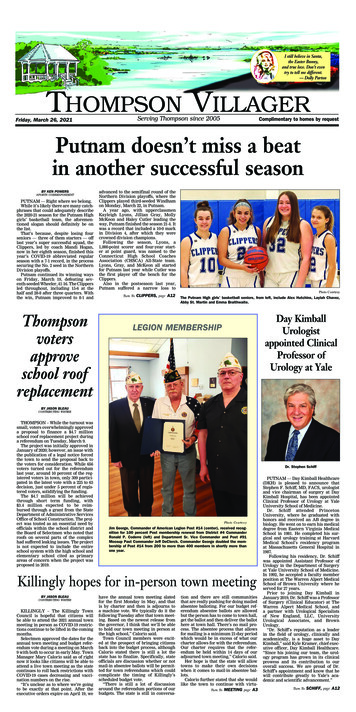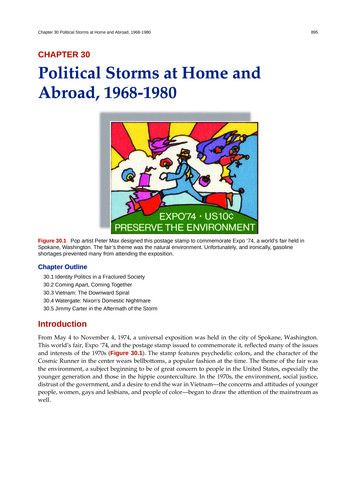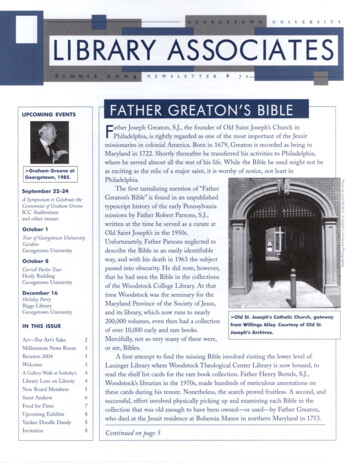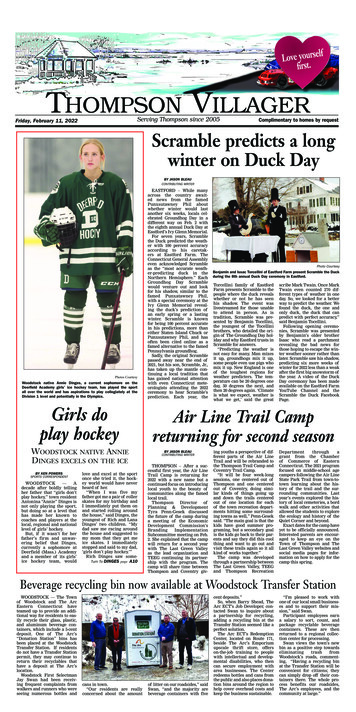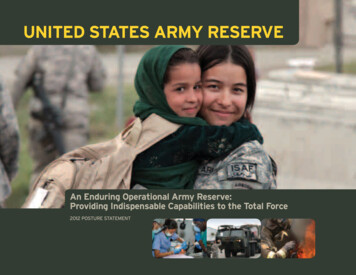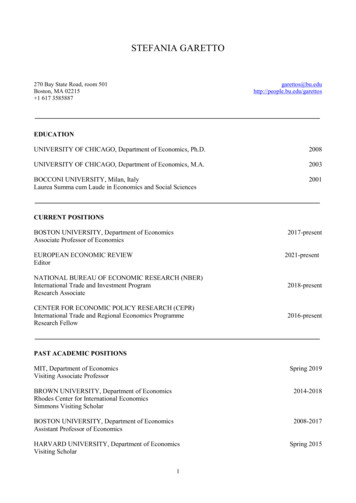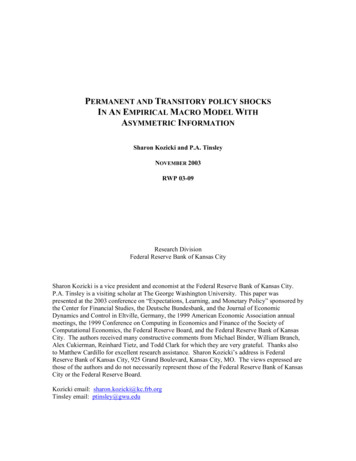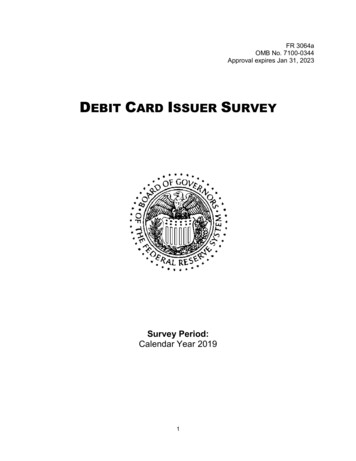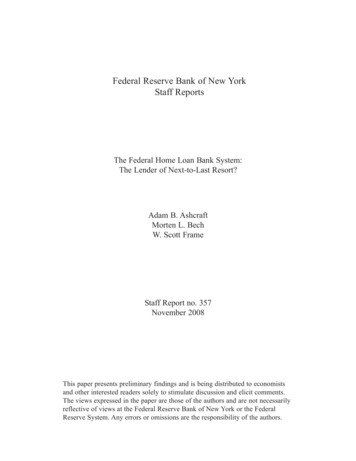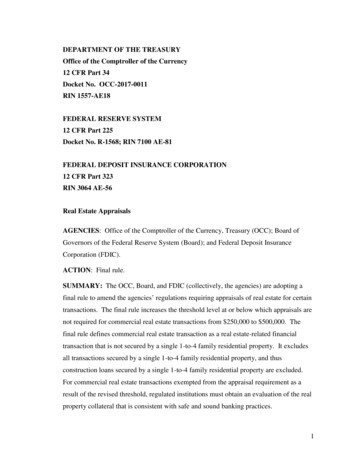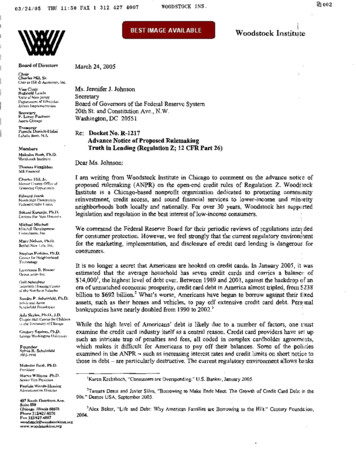
Transcription
03/24/05THU 11:50 FAX: 1 312 427 4007002WOODSTOCK INS.Woodstock InstituteBoard of DirectorsMarch 24, 2005ChairCharles Hill, Sr.Charles Hill & Associates, Inc.Ms. Jennifer J. JohnsonSecretaryBoard of Governors of the Federal Reserve System20th St. and Constitution Ave., N.W.Washington, DC 20551V i c e ChairReginald LewisState of New JerseyDepartment of EducationAbduct ImplementationSecretaryP. L e r o y P u e h c o nAssets CTreasurerPamela DanielsLaSalle Bank, N.A.Re: Docket No. R-1217Advance Notice of Proposed RulemakingTruth in Lending (Regulation Z; 12 CFR Part 26)MembersMalcolm B u s h . PH.DWoodstock InstituteDear Ms. Johnson:Thomas FitzgibbonMB FinancialC h u r l s , Kill. J r .Mecer County Office ofEconomic OpportunityHoward .JaenkNorth Side CommunityFederal Credit UnionSokuni Kuninja, PH.DCenter For New HorizonsMichael MitchellMitchell DevelopmentConsultants, Inc.M a r y N e l s o n , PH.D.Bethel New Life. Inc.Stephen P e r k i n s , PH.D.Center for NeighborhoodTechnologyLawrence B. RosserOpportunities, Inc.Gail SchechoerCounseling Housing Centerof the Northern SuburbsSandra P. Scheinfeld,Behin and AaronScheinfeld FoundationPh.D.Ada Skyles, PH.D., J.D.Chapin Hall Center for Childrenat the University of ChicagoGregory S q u i r e s . Ph.DGeorge Washington UniversityFounderSylvia R, Scheinfeld1903- 1990Malcolm Bush,PresidentI am writing from Woodstock Institute in Chicago to comment on the advance notice ofproposed rulemaking (ANPR) on the open-end credit rules of Regulation 2. WoodstockInstitute is a Chicago-based nonprofit organization dedicated to promoting communityreinvestment, credit access, and sound financial services to lower-income and minorityneighborhoods both locally and nationally. For over 30 years, Woodstock has supportedlegislation and regulation in the best interest of low-income consumers.We commend the Federal Reserve Board for their periodic reviews of regulations intercededfor consumer protection. However, we feel strongly that the current regulatory environmentfor the marketing, implementation, and disclosure of credit card lending is dangerous forconsumers.It is no longer a secret that Americans are hooked on credit cards. In January 2005, it wasestimated that the average household has seven credit cards and carries a balance of 14,000fo tnote1,the highest level of debt ever. Between 1989 and 2001, against the backdrop of anera of unmatched economic prosperity, credit card debt in America almost tripled, from 238billion to 692 billion.f2otne What's worse, Americans have begun to borrow against their fixedassets, such as their homes and vehicles, to pay off extensive credit card debt. Personalbankruptcies have nearly doubled from 1990 to 2002.3fotneWhile the high level of Americans' debt is likely due to a number of factors, one roustexamine the credit card industry itself as a central reason. Credit card providers have set upsuch an intricate trap of penalties and fees, all coded in complex cardholder agreements,which makes it difficult for Americans to pay off their balances. Some of the policiesexamined in the ANPR - such as increasing interest rates and credit limits on short notice tothose in debt - are particularly destructive. The current regulatory environment allows banksPh.D.Marvin Williams, P h . D .Senior Vice PresidentPatriciaWoods-HenningAdministrative Director4 0 ? S o u t h Dearborn A v e .Suite 550Chicago, Illinois 60605P h o n e 312/427-8070Fax king.orgfootnote1'Karen Krebsbach, "Consumers are Overspending." U.S. Banker, January 2005.footnote2Tamara Draur and Javier Silva, "Borrowing to Make Ends Meet; The Growth of Credit Card Debt in the90s." Demos USA, September 2003.footnote3AlexBaker, "Life and Debt: Why American Families are Borrowing to the Hilt." Century Foundation,2004.
03/24/05THU 11:51 FAX 1 312 427 4007003WOODSTOCK INS.Ms. Jennifer J. JohnsonBoard of Governors of the Federal Reserve SystemMarch 24, 2005Page 2to obscure important crucial information about their credit card products to incur penalties and fees.Banks' deceptive terms have led many Americans to undergo embarrassing bankruptcies, personal stress,and family problems.This letter will address the questions in the ANPR which we find most important:Abusive Fees, Q21-Q22, Q47-51Payment Allocation and Late Payments, Q34-36, Q47-51Change in Terms, Q26-Q27Woodstock Institute has also joined with a coalition of consumer advocacy organizations to form acollective letter; in its entirety, the joint letter addresses all of the questions presented in the ANPR.Abusive FeesWe feel it is necessary to discuss the fees presented in the ANPR within the context of the multitude offees currently imposed by the country's largest credit card lenders. The evidence suggests that fees areincreasing at a very rapid rate: in 1995, the industry generated 8.3 billion in all fees, and by 2003 thisnumber skyrocketed to 20.7 billion.4fotne This is largely due to the 1996 Smiley v. Citibank Supreme Courtdecision that allows banks to export higher fee ceilings from the states in which they are located. It is noaccident that banks have relocated their credit card processing centers to the states with the weakestconsumer protection laws. This section will address four types of credit card fees: late fees (Q47-51),over-the-limit fees (Q21-Q22), cash advance fees, and balance transfer fees. In addition to these, creditcards may also charge annual fees, set-up fees, credit-limit-increase fees, return-item fees, currencyconversion fees, and others.In December of 2004, Woodstock Institute collected data on the characteristics of credit cards offered, bythree groups of providers. The survey considered only what appeared to be the most basic or rioststandard credit card offered by each financial institution.f5otne The first group is banks: that is, the primarydepository institution of the largest U.S.-based bank and thrift holding companies, ranked by total amountof credit card loans.f6otne It is estimated that these ten institutions hold 90 percent of credit card accounts.Hereinafter, the term "bank" will be used to refer to institutions in this group. The cards surveyed arelisted in table 1.footnote4"DemosUSA, "Credit Card Industry Practices: In Brief," Found online atIndustryPractices WEB.pdf. Last accessed 6 January, d credit cards were not considered in the analysis, Many financial institutions have abandoned the traditionalconvention of offering three levels of cards based on creditworthiness, namely Standard/Classic, Gold, and Platinum cards, Thecards were considered regardless of brand (e.g., Visa, MasterCard, Diners Club, etc.)footnote 6 As published in the American Banker, 18, August, 2004. Data are accurate as of 31 March, 2004. From this list, USAABancorp was eliminated due to restraints on information, and FleetBoston financial Corp. was eliminated due to the merging ofits credit card products with Bank of America Corp.
03/24/05THU 11:51 FAX 1 312 427 4007WOODSTOCK INS.004Ms. Jennifer J. JohnsonBoard of Governors of the Federal Reserve SystemMarch 24, 2005Page 3Table 1Largest U.S.-Based Bank and Thrift Companies, Ranked byTotal Amount of Credit Card LoansInstitutionCitiGroup Inc.23456781011Bank Of America Corp.MBNA Corp.JP Morgan Chase & Co.Bank One Corp.WellsFargo & Co.US BancorpCapital One Financial Corp.National City Corp.BB&T Corp.Card SurveyedCiti Platinum Select MasterCardVisa GoldNFL Extra PointsChase Platinum MasterCardPlatinum Visa CardVisa Platinum CardVisa ClassicPlatinum MasterCardElite VisaPlatinum MasterCardTo provide contrast to the abusive practices instituted by banks, the survey also measured the fees o:' thecredit cards of two groups of credit unions. Credit unions illustrate the reality that credit card lending canbe done sustainably, but without instituting the exorbitant fees and unclear procedures that banks use.This is done in keeping with the credit unions movement's mission to provide sound and principledproducts to consumers of small means. The second group of credit card providers, listed in tableismade up of the ten largest credit unions nationwide, ranked by total amount of credit card loans.7fotne Thethird group, listed in table 3, is made up of the ten largest credit unions based in the Chicago MSA,ranked by total asset size.fo8tneOver-the-Limit Fees (Q21-22)The survey shows that, through the use of over-the-limit fees, banks are willing to take advantage of theiraccount holders' math errors. Many banks reserve the right to charge these fees when the consumerexceeds the limit by as little as 1, On this issue, banks' policies are more egregious than credit unions. Infact, the lowest over-the-limit fee charged by a bank in the sample ( 29) was higher than the highest feecharged by a national credit union ( 27). As shown in table 4, the banks' average of 33.60 far exceedsthe national credit unions' average of 17.90 and Chicago credit unions' average of 23.33. Only oneinstitution, a Chicago credit union, does not have an over-the-limit fee.footnote 7 As published in the American Banker, 16 November, 2004, Data are accurate as of 30 June, 2004,footnote8As determined through the 2004 Directory of Federally Insured Credit Unions, published by the National Credit UnionAdministration, Data for total amount of credit card loans for this group were not available,
03/24/05THU 11:52 FAX 1 312 427 4007005WOODSTOCK INS.Ms. Jennifer J. JohnsonBoard of Governors of the Federal Reserve SystemMarch 24, 2005Page 4Table 2Largest Credit Unions Nationwide, Ranked by Total Amount ofCredit Card LoansInstitution12345678910Navy FCUPentagon FCUSuncoast Schools FCUBoeing Employees CUPennsylvania State Employees CUDigital FCUOrange Co. Teachers FCUVystar FCUGolden 1 CUAmerica First CUCardSurveyedVisa ClassicVisa ClassicVisa ClassicVisaVisa Capitol CardVisa ClassicVisa ClassicVisa ClassicVisa ClassicVisa Classic (Option B)Table3Largest Credit Unions Based in the Chicago MSA, Ranked by Total Asset Size12Card SurveyedInstitutionAlliant CU345678910Regular MasterCardSelfreliance Ukrainian AmericanFCUBaxter CUCorporate America Family CUMotorola Employees CUGreat Lakes CUFirst Northern CUDuPage CUChicago Patrolmen's FCUIlliana Financial CUVisa Credit CardClassic VisaAdvantage VisaVisa ClassicVisa ClassicVisa ClassicVisa PlusVisa ClassicMasterCard RegularTable 4Over-the-Limit FeesLowestBanksNational CUsChicago CUsOTL Fees10 of 10lO of 109 of 10 29 10 10 39 27S351S33.60 17.90 23.33StanrtsrclDeviation3.415.666.61
03/24/05THU 11:52 FAX 1 312 427 4007WOODSTOCK INS.006Ms. Jennifer J. JohnsonBoard of Governors of the Federal Reserve SystemMarch 24, 2005Page 5Cash-Advance feesWhile cash advance fees were not explicitly mentioned in the ANPR, we find it is necessary to includethem to provide a context of all fees instituted on credit cards. This section only addresses the feesassociated with cash advances; banks also typically assign a higher APR to cash advances than topurchases (this will be addressed later in this letter under Payment Allocation and Late Payments). Thedata show that banks charge excessive fees for cash advances, whereas credit unions institute a muchmore modest fee. As table 5 shows, a majority of the credit unions don't charge cash advance feeswhatsoever.f9otne On average, banks charge a fee of 3.2 percent of each cash advance, but not to be lower thanan average "floor" of 6.50. While it may seem inappropriate that banks mandate a floor for cashadvances, it is even more alarming that all ten have no upper bound for cash advances. Thus, for a cashadvance of 1,000, the average bank would charge a fee of 32. Of the three national credit unions that dohave fees, the average fee is 1.93 percent of the advance; at the four Chicago credit unions, this number is2 percent. As shown in table 6, their fee floors are much lower.Table 5Cash Advance Fees**At one national credit union, there is a flat fee of fifty cents for a cash advance, regardless of the amount of the advance.Similarly at one Chicago credit union there is a flat 2 fee for cash advances. These two cases are not included in theabove table.footnote9At one national credit union, there is a fee of 50 cents for a cash advance, regardless of the amount of the advance.Similarly at one Chicago credit union, there is a 2 Fee for cash advances.
03/24/05THU 11:53 FAX 1 312 427 4007WOODSTOCK INS.Ms. Jennifer J. JohnsonBoard of Governors of the Federal Reserve SystemMarch 24, 2005Page 6Table 6Balance Transfer Fees**At two of the seven banks with balance transfer fees, there is no limit to the maximum amount of fee possible These twowere not included in this average.Balance-Transfer FeesSimilar to the above section on cash advances, this section only addresses the fees associated with balancetransfers; balance transfer rates will be discussed in the next section. As shown in table 7, banks chargemuch more for balance transfer fees, which are often poorly disclosed. All seven, banks that implementbalance transfer fees charge a rate of 3 percent of each transfer. All seven set a fee floor, which averages 6.43. What's worse, two of these banks have no maximum cap for a balance transfer fee (the other fivecap at an average of 63). This means that, for example, a balance transfer of 3,000 will incur a fee of 90 at one of these banks. On the other hand, eight often national credit unions and zero often Chicagocredit unions have balance transfer fees. At the two national credit unions that do charge for balancetransfers, the fee is 2 percent of the advance, with an average cap at S30.Table 7Late Fees* "Lowest" or "Highest" late fee refers to the lowest or highest value advertised, regardless of whether this value was partof a tiered system.007
03/24/05THU 11:53 FAX 1 312 427 4007008WOODSTOCK INS.Ms. Jennifer J. JohnsonBoard of Governors of the Federal Reserve SystemMarch 24, 2005Page 7Late fees (Q47-51)Providers have made late fees increasingly higher, and have introduced a number of schemes in order tomake more payments late (these schemes will be discussed later under "Payment Allocation and LatePayments"). Late fees are the golden goose of credit card providers. In 1996, the industry generated l.7billion in late fees; in 2002, it collected a whopping S7.3 billion.fo10tn e This increase was due in large part tothe aforementioned Smiley v. Citibank decision, which effectively eliminated state-instituted caps on latefees. According to a survey published by the Federal Reserve, nearly 30 percent of credit card users hadbeen charged a late fee in 2001.fo11tne The chief issue with late fees has become the clarity with which ;heyare presented. The survey found that eight of ten banks used a tiered system in assessing late fees. Forexample, a bank may charge a 15 late fee on a balances up to' lOO- 29 on balances of 100- 1,000; and 39 on balances of 1,000 and over. On the other hand, no national credit union and no Chicago creditunion used tiered systems, thus eliminating confusion. One national credit union, however, charges 5percent of the past due payment, but no more than 10. Due to the use of tiered systems, dollar-to-dollarcomparisons across the three groups were not made.Payment Allocation and Late PaymentsAs in the above section on abusive fees, we feel it is necessary to discuss payment allocation and latepayments by describing them in the context of credit card payments.Payment AllocationIn today's credit card market, a single credit card may have several APRs. For example, most have onerate for purchases, a higher rate for cash advances, a lower rate for balance transfers, and a fourth"default" or "penalty" rate. To add to this lack of clarity, a credit card provider may offer a lowerintroductory or promotional rate, but it may apply to only one of the rates- The promotional rate mayskyrocket to the default rate upon the first late payment or other penalty. Given this confusion, we feel thecentral issue at hand is clarity, not payment allocation. Use of multiple rates and teaser rates only bafflesthe consumer, and makes cost-shopping among credit cards increasingly difficult.In addition, that banks would allocate a consumer's payment to the lowest-rate balance First is additionalevidence that banks aggressively mine for profit on every aspect of credit card lending. AmendingRegulation 2 to address payment allocation would be appropriate: a pro-consumer method of allocationwould make it much easier for Americans to pay off their debt. The survey was unable to track date onpayment allocation, as it typically was not included in solicitation disclosures.footnote10Demos USA, "Credit Card Industry Practices: In Brief," Found online atIndustryPracticcs WEB.pdf. Last accessed 6 January as A. Durkin, "Consumers and Credit Disclosures: Credit Cards and Credit Insurance." Federal Reserve Bulletin,April 2002.
03/24/05THU 11:54 FAX 1 312 427 4007WOODSTOCK INS.009Ms. Jennifer J. JohnsonBoard of Governors of the Federal Reserve SystemMarch 24, 2005Page 8Late PaymentsEvidence shows that banks have instituted many schemes to maximize the number of payments that areconsidered "late" (late fees were addressed earlier under "Abusive Fees"). First, many providers havesqueezed the grace period for repayment from an industry-standard of 30 days down to 20 days toincrease the likelihood of a late payment, as the survey exhibits in table 8. In contrast, credit unions' eraceperiods are longer. Second, anecdotal evidence shows that some providers periodically switch !heirpayment address among multiple P.O. boxes, so that payments are bounced around the card processingcenter to cause a further delay.footnote12Table 8Grace Periods* Grace period is defined as the number of days between the close of the billing cycle and the date the payment is due.Many banks have also instituted a payment cut-off time at 1 p.m. on the due date; thus, if the letter carrieris late that day, so is the payment. A 2004 survey by Consumer Action showed that 58 percent ofsurveyed banks now have a cut-off time.fo13tn e Furthermore, anecdotal evidence shows that banks whoseprocessing centers are located in the central time zone will establish their payment at 1 pm. eastern time,effectively making payment due at noon. Then, if mail is delivered until after the cut-off time on that day,the grace period is cut short by one day. Given these circumstances, the Board ought to amend RegulationZ requiring creditors to credit payment as of the date they are received, regardless of time.Change in TermsThe ANPR's inquiry regarding change in terms (Q26-Q27) exhibits how the Board could amendRegulation Z to prohibit the controversial practice of "universal default." Under current practice, a creditcard provider reserves the right to increase a consumer's interest rate when (s)he is late or delinquent withfootnote12AmyC. Fleitas, "20 Snaky Credit Card Tricks." Found online at Last accessed 4 January, 2004.footnote13Linda Sherry et.al, "Credit Card Survey 2004," Consumer Action News, Spring 2004
03/24/05THU 11:54 FAX 1 312 427 4007i]01OWOODSTOCK INS.Ms. Jennifer J. JohnsonBoard of Governors of the Federal Reserve SystemMarch 24, 20Q5Page 9an entirely different creditor or utility provider,1" which is done through an arrangement with one of thethree credit bureaus. Thus, if a consumer is late with Bank X, Bank Y could raise its rate, even if theconsumer has never missed a payment with Bank Y. Usually, the rate skyrockets to the default .rate;among the ten banks in the survey, this rate averaged 25.4 percent. It becomes very difficull forconsumers to pay off their balances at rates this high. Data show that universal default is catching on: a2004 survey by Consumer Action of California showed that 39 percent of its sample of bank credit curdsimplemented universal default.15The Board is poised to stop universal default: the practice could be ended by amending Regulation Z toby requiring 30 days' advance notice or longer when a consumer is in default or delinquency with anothercreditor. Universal default is premised on the consumer's ignorance of the procedures for changing therate: an extended advance notice period will allow consumer to realize their mistakes, and perlapstransfer his/her balance from the high rate card to another card. We feel strongly that this is a particulardeceptive practice and ought to be eliminated.SummaryIn sum, this ANPR gives the BoaTd the occasion to act in the best interest of the consumer by ending anumber of credit card providers' most deceptive practices. Among these, the Board has the opportunity toend unreasonable fees, deceptive payment allocation, cut-off times, and universal default. Given that thepurpose of the Truth in Lending Act is to encourage competition through the informed use of credit, wefeel that it is critical to end these detrimental practices.Furthermore, as our colleagues will argue in our joint letter, the Board also has the opportunity to mikeinformation about credit card products presented in a clearer and more uniform way. This will facilitatebetter cost-shopping among credit cards and other forms of credit, and so that consumers can be fi illyknowledgeable of the products they use. While we understand that the cost structures are different in thecredit union sector, as this comparison shows, credit union credit card products are much more consun erfriendly that bank products and should be viewed as better practices.Sincerely,Malcolm BushPresidentMB/bab'"Lucy Lazarony, "Credit card companies look to raise your rates by spying on your credit." Bankrate.eorn, found onliiU1 at;hnp://www/bankratexorn/bnn/nows/cc/l 99905 24,asp. Last accessed 4 January, 2004.lsUnda Sherry en&l, "Credit Card Survey 2004." Consumer Action News, Spring'2004., .
Data are accurat 31 Marche as, o 2004f . From this list, USAA Bancorp was eliminated due to restraints on information, and FleetBoston financial Corp. was eliminated due to the merging of . 6 WellsFargo & Co. Visa Platinum Card 7 US Bancorp Visa Classic 8 Capital One Financial Corp . 9 Chicago Patrolmen's FCU Visa Classic 10 Illiana .
